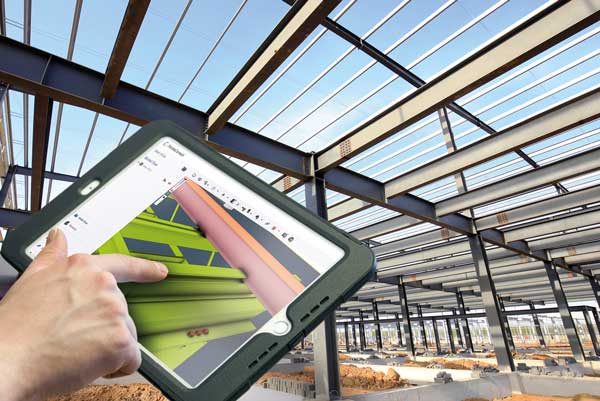Projects and Features
Digital Twins

SHM was used on the Forth Road Bridge to monitor its health remotely (Photo: Ulmus Media – Shutterstock)
Emerging digital technologies have the potential to help the steel construction industry to be more connected and transparent resulting in increased efficiencies in workflow and communication. In this article NSC looks at one of those technologies, namely digital twins.
The steel construction sector has been utilising 3D design software for over 25 years and is well versed in the benefits and efficiencies it provides to manufacturing and construction programmes. The sector is also on the front foot in looking at and incorporating new digital technologies to reduce costs, increase speed of project deliveries and increase environmental sustainability. One of these emerging technologies is digital twins.
A digital twin can be generally defined as an evolving digital profile of a physical object or process that helps optimise performance. Computer-aided design (CAD) or finite element analysis (FEA) models are already widely used in the steel construction industry, but they should not be confused with digital twins. A value which distinguishes those models from digital twins is the presence of a two-way connection between a digital twin and its physical counterpart. A digital twin can be continuously updated with operational data from the physical twin, while the data can be analysed, for instance with machine learning techniques, to make predictions about the performance of the physical twin, to enable preventive measures and positive interventions to take place.

A digital twin of Singapore has been set up to optimise infrastructure planning (Photo: Tavarious – Shutterstock)
Existing applications
Digital twins have been applied in numerous industries, e.g. Tesla has a digital twin of every car it produces, which enables the company to collect data from the vehicles to discover anomalies and rectify them by updating the software of the cars. General Electric uses digital twins to increase the efficiency of their power turbines and aeroplane engines. On a larger scale, Virtual Singapore is a digital twin which models the built environment of its country, which optimises its use and planning of infrastructure. Likewise, the National Digital Twin for infrastructure is being set up in the United Kingdom to act as a federation of digital twins connected through shared data.
Potential applications in steel construction
To date there are minimal existing applications of digital twins in steel construction, but in the following paragraphs we explore some of the potential uses.
Structural Health Monitoring (SHM)
An SHM system collects data from sensors deployed on a structure and consecutively processes them to indicate the structural health of the structure. The types of sensors deployed are based on the readings required, which can be displacements, temperature, and loading etc. For example, an SHM system was deployed recently on the Forth Road Bridge in Scotland to monitor its structural health remotely.
Machine learning algorithms were used to predict the future performance of the bridge based on historical data from sensors. Those predictions were then compared to actual sensor readings to enable more accurate future predictions. As a result, SHM systems can automatically produce early warnings of deterioration allowing preventive maintenance to take place.
Project management
It is also possible to have digital twins of construction sites to assist in project management, in which they can be used for progress and cost monitoring, as well as quality control. Real-time information on a construction project can be obtained by integrating a digital twin with the project’s Building Information Model (BIM) and by utilising modern technologies such as drones and laser scanning. The information retrieved can then be used to derive real-time metrics of a project, which include comparisons of a project’s progress against its schedule and expenditure against its budget. Discrepancies between as-built conditions and designs can also be captured by potentially using artificial intelligence for cross-referencing. As a result, the digital twin can act as a platform to have a dynamic overview of a project, featuring its real-time metrics and warnings of potential problems, such as cost overruns, slow progress or construction errors.
Inventory management
A digital twin can be implemented for inventory management to reduce unnecessary handling and movement of materials, which accounts for 25% of the on-site productive time. Tagging and tracking of materials can be conducted with sensors, such as near field technology communication (NFC) devices, or with the use of QR codes. The digital twin can then predict the anticipated demand for the materials, and subsequently, notify site managers when the restocking of the materials is required.
Health & Safety
A digital twin of a construction site can improve on-site safety to reduce the number of accidents. The digital twin can obtain information about danger zones or hazardous activities either by reports made manually or by automatically identifying them with artificial intelligence through on-site camera footage. Simultaneously, smart helmets with inbuilt sensors can track the real-time locations of users, which can be linked to the digital twin to automatically alert workers when they are near a danger zone.
Outlook
Due to reductions in the cost of sensors and improvement in network connectivity, there are positive prospects for a broader application of digital twins in steel construction. With regard to the SHM application of digital twins, it is time-consuming to process data and simulate structural models, but there is potential for close to real-time monitoring of structural health in the future due to increased computational efficiencies.
There is also much more potential in utilising data from digital twins, for instance, to monitor structural health remotely and to leverage existing structural performance data to optimise structural designs of future projects.
 Sponsors
Sponsors
Software
Silver: Trimble Solutions (UK) Ltd
Thanks to Imperial College London for contributing to this article.











